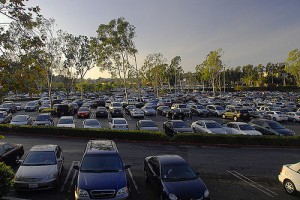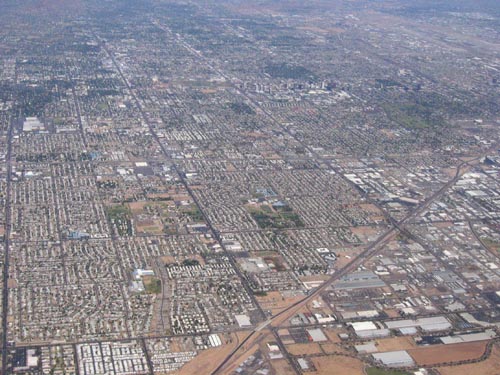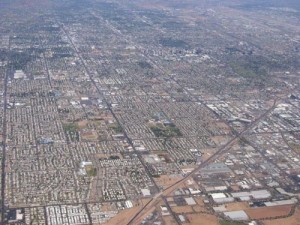With Earth Day (April 22) just around the corner, let’s take this week to reflect on the sustainability challenges here in Phoenix.
What are the biggest sustainability challenges we face in Phoenix?
These are my top 3:
1. SPRAWL –
The Problem:
- increased emissions into our atmosphere
- increased dependence on foreign oil
- an ever-increasing expansion of highways built on land that could be used more sustainably
- swaths of abandoned foreclosed homes in failed housing developments in far-flung suburbs such as Coolidge, Surprise, and Maricopa
sprawl in Phoenix – photo from The Anthropik Network
Suggested Solutions:
- telecommuting
- build work hubs within existing suburbs eliminating the need to commute long distances
- high-speed rail from the suburbs into the city
- light rail extensions further into the suburbs
- incentivize developers to rehabilitate existing buildings or build on infill lots through expedited permitting, lower parking requirements, possible rebates and tax incentives
2. Our dependence on the automobile –
The Problem:
- increased emissions into the atmosphere
- tons of expensive foreign oil consumed
- inefficient use of our land due to urban planning around the car

super-wide neighborhood streets in Phoenix – photo from Hecate
Suggested Solutions:
- build areas in the city geared towards pedestrians, bikes and public transportation.
- add bike lanes to all our streets.
- require bike racks in the Phoenix Building Code for new buildings and tenant improvements. Take a look at this map created by Tony Arranaga The Light Rail Blogger and Jim McPherson of The Arizona Preservation Foundation showing bike rack locations around Central Phoenix, let’s populate this thing.
- narrow our super-wide neighborhood streets to be more friendly to bikes and pedestrians by adding bike lanes, benches, landscaping, wider walking
paths and shade. The City of Tempe has done a nice job with this with some of their neighborhoods.
- decrease parking requirements in the Phoenix Building Code for businesses in Central Phoenix – encourage people to use alternative transportation.
- increase the efficiency/punctuality/reliability and expand the routes of our buses and light rail.
3. Water –
The Problem:
- We live in a desert people!
- We get our water from the Colorado River through our canal system, reclaimed water and the Salt River ground water. Experts are saying that even if the Colorado River source dries up for us, we can rely on our ample ground water.
- Here’s the problem: run-off from all the asphalt in Phoenix (think surface parking) is polluting our ground water.

sea of parking, a familiar site in Phoenix – photo from treehugger.com
Suggested Solutions:
- increase the cost of water – right now it’s too cheap so even if you use tons of water, your water bill will be extremely low in Phoenix.
- plant native low-water consuming plants in your home – consult Doreen Pollack The Garden Goddess for help on this.
- require permeable parking surfaces in the Phoenix Building Code that help water naturally seep into the earth, replenishing our ground water reserves instead of asphalt parking lots that pollute our ground water and cause the heat island effect.
- require native, low-water consuming landscaping in the City of Phoenix Zoning Ordinance for new businesses and multi-family residential development.
- require low-flow plumbing fixtures for businesses and residences in the Phoenix Building Code.
- encourage gray-water systems for residences with rebates and tax incentives.
These are huge issues facing us, and there are lots of different ways we can start addressing them. We have to start somewhere, and becoming aware of the problem is the first step. So what are other sustainability challenges we face in Phoenix and what are some of your
suggested solutions? Leave me a comment and let’s start a discussion!
If you want to receive news and tips on modern and sustainable architecture in Phoenix, make sure to subscribe to the Blooming Rock Newsletter!





















[…] is only 2 days away), I’m reflecting on some of the sustainability challenges in Phoenix. In yesterday’s post I outlined 3 of the biggest sustainability challenges we face. Today I’d like to focus in on […]
[…] Earth Day 2010 (tomorrow!) I’m focusing on sustainability issues in Phoenix. Monday I touched on 3 of the biggest sustainability challenges in Phoenix and yesterday I focused on the over abundance of parking in our city center. But we can’t talk […]
Good post and nice to see your blog becoming so active. I agree with 90% of the post but want to take exception to one item: “build work hubs within existing suburbs eliminating the need to commute long distances.”
This idea has been tried for decades in many places, including Phoenix. In theory, decentralized employment makes sense, but what I’ve observed is that job sprawl is actually more pernicious than residential sprawl.
First, the labor market is so specialized that even if someone finds works near his or her exurban home, it is likely that person’s spouse or significant other will face a long cross-town commute to find work in another location. Even worse, if the exurbanite loses his or her job, the next job available may be in an equally far-flung location on the other side of the metro area. Imagine living in Anthem and working for an employer on Happy Valley Road in far north Phoenix. If that job goes away, the next job might be in Chandler. The net result is a lot of people end up with suburb-to-suburb commutes, which are notoriously hard to address via transit.
Second, job sprawl enables additional waves of residential sprawl. Let’s say 25 miles is the maximum acceptable commute for someone. If employment is relatively centralized, then that person has little reason to look for housing in the outermost rings of suburbia. If, however, there is a big employment base in suburbia, then suddenly that person’s range of possibilities goes 25 miles farther out. If major employment centers are located in Surprise, then suddenly living all the way out in Wittman doesn’t look so bad.
Fortunately, Phoenix actually ranked fairly low in terms of job sprawl in a recent survey by the Brookings Institution. Contrary to stereotypes, our employment base is heavily centralized, even if much of it lies outside the traditional confines of Downtown. I hope we can keep it that way. I understand suburban living, and that can be sustained via good transit (the old concept of “streetcar suburbs”), but exurban employment seems like a failed concept.
David, great points! I didn’t think about the ripple effects of decentralized employment. You’re right that if we had mostly a centralized hub, then that would be plenty incentive for people to live close to work. Also I think with our current technological advancements, so many people can work from home and avoid a commute all together, or maybe commute only some days out of the week or month. But your argument still holds that if we had a centralized location of employment, then even those few commutes would come from people living nearby, not way out in the suburbs. Also centralized employment that would lead to centralized housing which in turn would lead to centralized retail and entertainment which would eliminate most reasons why people would want to live way out in the suburbs.
I’m surprised that Phoenix ranked low in terms of job sprawl – so why do we have such epidemic residential sprawl?